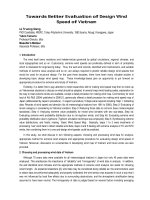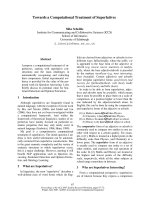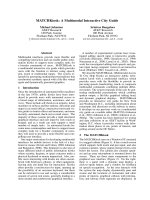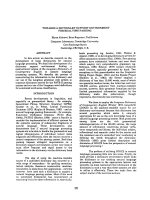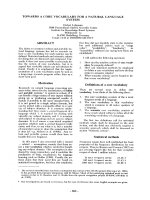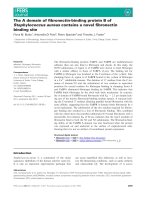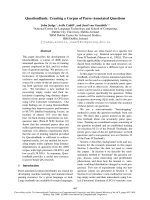Báo cáo khoa học: "Towards a Model of Face-to-Face Grounding" pptx
Bạn đang xem bản rút gọn của tài liệu. Xem và tải ngay bản đầy đủ của tài liệu tại đây (347.25 KB, 9 trang )
Towards a Model of Face-to-Face Grounding
Yukiko I. Nakano
†/††
Gabe Reinstein
†
Tom Stocky
†
Justine Cassell
†
†
MIT Media Laboratory
E15-315
20 Ames Street
Cambridge, MA 02139 USA
{yukiko, gabe, tstocky, justine}@media.mit.edu
††
Research Institute of Science and
Technology for Society (RISTEX)
2-5-1 Atago Minato-ku,
Tokyo 105-6218, Japan
Abstract
We investigate the verbal and nonverbal
means for grounding, and propose a design
for embodied conversational agents that re-
lies on both kinds of signals to establish
common ground in human-computer inter-
action. We analyzed eye gaze, head nods
and attentional focus in the context of a di-
rection-giving task. The distribution of
nonverbal behaviors differed depending on
the type of dialogue move being grounded,
and the overall pattern reflected a monitor-
ing of lack of negative feedback. Based on
these results, we present an ECA that uses
verbal and nonverbal grounding acts to up-
date dialogue state.
1 Introduction
An essential part of conversation is to ensure that
the other participants share an understanding of
what has been said, and what is meant. The proc-
ess of ensuring that understanding – adding what
has been said to the common ground – is called
grounding [1]. In face-to-face interaction, nonver-
bal signals as well as verbal participate in the
grounding process, to indicate that an utterance is
grounded, or that further work is needed to ground.
Figure 1 shows an example of human face-to-face
conversation. Even though no verbal feedback is
provided, the speaker (S) continues to add to the
directions. Intriguingly, the listener gives no ex-
plicit nonverbal feedback – no nods or gaze to-
wards S. S, however, is clearly monitoring the
listener’s behavior, as we see by the fact that S
looks at her twice (continuous lines above the
words). In fact, our analyses show that maintaining
focus of attention on the task (dash-dot lines un-
derneath the words) is the listener’s public signal
of understanding S’s utterance sufficiently for the
task at hand. Because S is manifestly attending to
this signal, the signal allows the two jointly to rec-
ognize S’s contribution as grounded. This paper
provides empirical support for an essential role for
nonverbal behaviors in grounding, motivating an
architecture for an embodied conversational agent
that can establish common ground using eye gaze,
head nods, and attentional focus.
Although grounding has received significant at-
tention in the literature, previous work has not ad-
dressed the following questions: (1) what
predictive factors account for how people use non-
verbal signals to ground information, (2) how can a
model of the face-to-face grounding process be
used to adapt dialogue management to face-to-face
conversation with an embodied conversational
agent. This paper addresses these issues, with the
goal of contributing to the literature on discourse
phenomena, and of building more advanced con-
versational humanoids that can engage in human
conversational protocols.
In the next section, we discuss relevant previous
work, report results from our own empirical study
and, based on our analysis of conversational data,
propose a model of grounding using both verbal
and nonverbal information, and present our im-
plementation of that model into an embodied con-
versational agent. As a preliminary evaluation, we
compare a user interacting with the embodied con-
versational agent with and without grounding.
Figure 1: Human face-to-face conversation
[580] S: Go to the fourth floor,
[590] S: hang a left,
[600] S: hang another left.
look at map gaze at listener
gaze at listener
look at map
look at map
look at map
look at map
speaker’s
behavior
listener’s
behavior
[580] S: Go to the fourth floor,
[590] S: hang a left,
[600] S: hang another left.
look at map gaze at listener
gaze at listener
look at map
look at map
look at map
look at map
speaker’s
behavior
listener’s
behavior
2 Related Work
Conversation can be seen as a collaborative activ-
ity to accomplish information-sharing and to pur-
sue joint goals and tasks. Under this view,
agreeing on what has been said, and what is meant,
is crucial to conversation. The part of what has
been said that the interlocutors understand to be
mutually shared is called the common ground, and
the process of establishing parts of the conversa-
tion as shared is called grounding [1]. As [2] point
out, participants in a conversation attempt to
minimize the effort expended in grounding. Thus,
interlocutors do not always convey all the informa-
tion at their disposal; sometimes it takes less effort
to produce an incomplete utterance that can be re-
paired if needs be.
[3] has proposed a computational approach to
grounding where the status of contributions as
provisional or shared is part of the dialogue
system’s representation of the “information state”
of the conversation. Conversational actions can
trigger updates that register provisional
information as shared. These actions achieve
grounding. Acknowledgment acts are directly as-
sociated with grounding updates while other utter-
ances effect grounding updates indirectly, because
they proceed with the task in a way that presup-
poses that prior utterances are uncontroversial.
[4], on the other hand, suggest that actions in
conversation give probabilistic evidence of under-
standing, which is represented on a par with other
uncertainties in the dialogue system (e.g., speech
recognizer unreliability). The dialogue manager
assumes that content is grounded as long as it
judges the risk of misunderstanding as acceptable.
[1, 5] mention that eye gaze is the most basic
form of positive evidence that the addressee is at-
tending to the speaker, and that head nods have a
similar function to verbal acknowledgements. They
suggest that nonverbal behaviors mainly contribute
to lower levels of grounding, to signify that inter-
locutors have access to each other’s communica-
tive actions, and are attending. With a similar goal
of broadening the notion of communicative action
beyond the spoken word, [6] examine other kinds
of multimodal grounding behaviors, such as post-
ing information on a whiteboard. Although these
and other researchers have suggested that nonver-
bal behaviors undoubtedly play a role in grounding,
previous literature does not characterize their pre-
cise role with respect to dialogue state.
On the other hand, a number of studies on these
particular nonverbal behaviors do exist. An early
study, [7], reported that conversation involves eye
gaze about 60% of the time. Speakers look up at
grammatical pauses for feedback on how utter-
ances are being received, and also look at the task.
Listeners look at speakers to follow their direction
of gaze. In fact, [8] claimed speakers will pause
and restart until they obtain the listener’s gaze. [9]
found that during conversational difficulties, mu-
tual gaze was held longer at turn boundaries.
Previous work on embodied conversational
agents (ECAs) has demonstrated that it is possible
to implement face-to-face conversational protocols
in human-computer interaction, and that correct
relationships among verbal and nonverbal signals
enhances the naturalness and effectiveness of em-
bodied dialogue systems [10], [11]. [12] reported
that users felt the agent to be more helpful, lifelike,
and smooth in its interaction style when it demon-
strated nonverbal conversational behaviors.
3 Empirical Study
In order to get an empirical basis for modeling
face-to-face grounding, and implementing an ECA,
we analyzed conversational data in two conditions.
3.1 Experiment Design
Based on previous direction-giving tasks, students
from two different universities gave directions to
campus locations to one another. Each pair had a
conversation in a (1) Face-to-face condition
(F2F): where two subjects sat with a map drawn
by the direction-giver sitting between them, and in
a (2) Shared Reference condition (SR): where an
L-shaped screen between the subjects let them
share a map drawn by the direction-giver, but not
to see the other’s face or body.
Interactions between the subjects were video-
recorded from four different angles, and combined
by a video mixer into synchronized video clips.
3.2 Data Coding
10 experiment sessions resulted in 10 dialogues per
condition (20 in total), transcribed as follows.
Coding verbal behaviors: As grounding oc-
curs within a turn, which consists of consecutive
utterances by a speaker, following [13] we token-
ized a turn into utterance units (UU), correspond-
ing to a single intonational phrase [14]. Each UU
was categorized using the DAMSL coding scheme
[15]. In the statistical analysis, we concentrated on
the following four categories with regular occur-
rence in our data: Acknowledgement, Answer, In-
formation request (Info-req), and Assertion.
Coding nonverbal behaviors: Based on previ-
ous studies, four types of behaviors were coded:
Gaze At Partner (gP): Looking at the partner’s
eyes, eye region, or face.
Gaze At Map (gM): Looking at the map
Gaze Elsewhere (gE): Looking away elsewhere
Head nod (Nod): Head moves up and down in a
single continuous movement on a vertical axis,
but eyes do not go above the horizontal axis.
By combining Gaze and Nod, six complex catego-
ries (ex. gP with nod, gP without nod, etc) are gen-
erated. In what follows, however, we analyze only
categories with more than 10 instances. In order to
analyze dyadic behavior, 16 combinations of the
nonverbal behaviors are defined, as shown in Table
1. Thus, gP/gM stands for a combination of
speaker gaze at partner and listener gaze at map.
Results
We examine differences between the F2F and SR
conditions, correlate verbal and nonverbal behav-
iors within those conditions, and finally look at
correlations between speaker and listener behavior.
Basic Statistics: The analyzed corpus consists
of 1088 UUs for F2F, and 1145 UUs for SR. The
mean length of conversations in F2F is 3.24 min-
utes, and in SR is 3.78 minutes (t(7)=-1.667 p<.07
(one-tail)). The mean length of utterances in F2F
(5.26 words per UU) is significantly longer than in
SR (4.43 words per UU) (t(7)=3.389 p< .01 (one-
tail)). For the nonverbal behaviors, the number of
shifts between the statuses in Table 1 was com-
pared (eg. NV status shifts from gP/gP to gM/gM
is counted as one shift). There were 887 NV status
shifts for F2F, and 425 shifts for SR. The number
of NV status shifts in SR is less than half of that in
F2F (t(7)=3.377 p< .01 (one-tail)).
These results indicate that visual access to the
interlocutor’s body affects the conversation, sug-
gesting that these nonverbal behaviors are used as
communicative signals. In SR, where the mean
length of UU is shorter, speakers present informa-
tion in smaller chunks than in F2F, leading to more
chunks and a slightly longer conversation. In F2F,
on the other hand, conversational participants con-
vey more information in each UU.
Correlation between verbal and nonverbal
behaviors: We analyzed NV status shifts with re-
spect to the type of verbal communicative action
and the experimental condition (F2F/SR). To look
at the continuity of NV status, we also analyzed the
amount of time spent in each NV status. For gaze,
transition and time spent gave similar results; since
head nods are so brief, however, we discuss the
data in terms of transitions.
Table 2 shows the most
frequent target NV status (shift to these statuses from
others) for each speech act type in F2F. Numbers in
parentheses indicates the proportion to the total num-
ber of transitions.
<Acknowledgement> Within an UU, the
dyad’s NV status most frequently shifts to
gMwN/gM (eg. speaker utters “OK” while nodding,
and listener looks at the map). At pauses, a shift to
gMgM is most frequent. The same results were
found in SR where the listener could not see the
speaker’s nod. These findings suggest that Ac-
knowledgement is likely to be accompanied by a
head nod, and this behavior may function intro-
spectively, as well as communicatively.
<Answer> In F2F, the most frequent shift
within a UU is to gP/gP. This suggests that speak-
ers and listeners rely on mutual gaze (gP/gP) to
ensure an answer is grounded, whereas they cannot
use this strategy in SR. In addition, we found that
Table 1: NV statuses
Listener’s behavior Combinations of
NVs
gP gM gMwN gE
gP gP/gP gP/gM gP/gMwN gP/gE
gM gM/gP gM/gM gM/gMwN gM/gE
gMwN gMwN/gP gMwN/gM gMwN/gMwN gMwN/gE
Speaker’s
behavior
gE gE/gP gE/gM gE/gMwN gE/gE
Shift to
within UU pause
Acknowledgement gMwN/gM (0.495) gM/gM (0.888)
Answer gP/gP (0.436) gM/gM (0.667)
Info-req gP/gM (0.38) gP/gP (0.5)
Assertion gP/gM (0.317) gM/gM (0.418)
Table 2: Salient transitions
speakers frequently look away at the beginning of
an answer, as they plan their reply [7].
<Info-req> In F2F, the most frequent shift
within a UU is to gP/gM, while at pauses between
UUs shift to gP/gP is the most frequent. This sug-
gests that speakers obtain mutual gaze after asking
a question to ensure that the question is clear, be-
fore the turn is transferred to the listener to reply.
In SR, however, rarely is there any NV status shift,
and participants continue looking at the map.
<Assertion> In both conditions, listeners look
at the map most of the time, and sometimes nod.
However, speakers’ nonverbal behavior is very
different across conditions. In SR, speakers either
look at the map or elsewhere. By contrast, in F2F,
they frequently look at the listener, so that a shift
to gP/gM is the most frequent within an UU. This
suggests that, in F2F, speakers check whether the
listener is paying attention to the referent men-
tioned in the Assertion. This implies that not only
listener’s gazing at the speaker, but also paying
attention to a referent works as positive evidence
of understanding in F2F.
In summary, it is already known that eye gaze
can signal a turn-taking request [16], but turn-
taking cannot account for all our results. Gaze di-
rection changes within as well as between UUs,
and the usage of these nonverbal behaviors differs
depending on the type of conversational action.
Note that subjects
rarely demonstrated communica-
tion failures, implying that these nonverbal behaviors
represent positive evidence of grounding.
Correlation between speaker and listener
behavior: Thus far we have demonstrated a differ-
ence in distribution among nonverbal behaviors,
with respect to conversational action, and visibility
of interlocutor. But, to uncover the function of
these nonverbal signals, we must examine how
listener’s nonverbal behavior affects the speaker’s
following action. Thus, we looked at two consecu-
tive Assertion UUs by a direction-giver, and ana-
lyzed the relationship between the NV status of the
first UU and the direction-giving strategy in the
second UU. The giver’s second UU is classified as
go-ahead if it gives the next leg of the directions,
or as elaboration if it gives additional information
about the first UU, as in the following example:
[U1]S: And then, you’ll go
down this little corridor.
[U2]S: It’s not very long.
Results are shown in Figure 2. When the listener
begins to gaze at the speaker somewhere within an
UU, and maintains gaze until the pause after the
UU, the speaker’s next UU is an elaboration of the
previous UU 73% of the time. On the other hand,
when the listener keeps looking at the map during
an UU, only 30% of the next UU is an elaboration
(z = 3.678, p<.01). Moreover, when a listener
keeps looking at the speaker, the speaker’s next
UU is go-ahead only 27% of the time. In contrast,
when a listener keeps looking at the map, the
speaker’s next UU is go-ahead 52% of the time (z
= -2.049, p<.05)
1
. These results suggest that speak-
ers interpret listeners’ continuous gaze as evidence
of not-understanding, and they therefore add more
information about the previous UU. Similar find-
ings were reported for a map task by [17] who
suggested that, at times of communicative diffi-
culty, interlocutors are more likely to utilize all the
channels available to them. In terms of floor man-
agement, gazing at the partner is a signal of giving
up a turn, and here this indicates that listeners are
trying to elicit more information from the speaker.
In addition, listeners’ continuous attention to the
map is interpreted as evidence of understanding,
and speakers go ahead to the next leg of the direc-
tion
2
.
3.3 A Model of Face-to-Face Grounding
Analyzing spoken dialogues, [18] reported that
grounding behavior is more likely to occur at an
1
The percentage for map does not sum to 100% because some
of the UUs are cue phrases or tag questions which are part of
the next leg of the direction, but do not convey content.
2
We also analyzed two consecutive Answer UUs from a giver,
and found that when the listener looks at the speaker at a
pause, the speaker elaborates the Answer 78% of the time.
When the listener looks at the speaker during the UU and at
the map after the UU (positive evidence), the speaker elabo-
rates only 17% of the time.
0
0.1
0.2
0.3
0.4
0.5
0.6
0.7
0.8
gaze map
elaboration
go-ahead
0
0.1
0.2
0.3
0.4
0.5
0.6
0.7
0.8
gaze map
elaboration
go-ahead
Figure 2: Relationship between receiver’s NV and
giver’s next verbal behavior
intonational boundary, which we use to identify
UUs. This implies that multiple grounding behav-
iors can occur within a turn if it consists of multi-
ple UUs. However, in previous models,
information is grounded only when a listener re-
turns verbal feedback, and acknowledgement
marks the smallest scope of grounding. If we ap-
ply this model to the example in Figure 1, none of
the UU have been grounded because the listener
has not returned any spoken grounding clues.
In contrast, our results suggest that considering
the role of nonverbal behavior, especially eye-gaze,
allows a more fine-grained model of grounding,
employing the UU as a unit of grounding.
Our results also suggest that speakers are ac-
tively monitoring positive evidence of understand-
ing, and also the absence of negative evidence of
understanding (that is, signs of miscommunication).
When listeners continue to gaze at the task, speak-
ers continue on to the next leg of directions.
Because of the incremental nature of grounding,
we implement nonverbal grounding functionality
into an embodied conversational agent using a
process model that describes steps for a system to
judge whether a user understands system contribu-
tion: (1) Preparing for the next UU: according to
the speech act type of the next UU, nonverbal posi-
tive or negative evidence that the agent expects to
receive are specified. (2) Monitoring: monitors and
checks the user’s nonverbal status and signals dur-
ing the UU. After speaking, the agent continues
monitoring until s/he gets enough evidence of un-
derstanding or not-understanding represented by
user’s nonverbal status and signals.(3) Judging:
once the agent gets enough evidence, s/he tries to
judge groundedness as soon as possible. According
to some previous studies, length of pause between
UUs is in between 0.4 to 1 sec [18, 19]. Thus, time
out for judgment is 1 sec after the end of the UU. If
the agent does not have evidence then, the UU re-
mains ungrounded.
This model is based on the information state
approach [3], with update rules that revise the state
of the conversation based on the inputs the system
receives. In our case, however, the inputs are sam-
pled continuously, include the nonverbal state, and
only some require updates. Other inputs indicate
that the last utterance is still pending, and allow the
agent to wait further. In particular, task attention
over an interval following the utterance triggers
grounding. Gaze in the interval means that the
contribution stays provisional, and triggers an ob-
ligation to elaborate. Likewise, if the system
times-out without recognizing any user feedback,
the segment remains ungrounded. This process
allows the system to keep talking across multiple
utterance units without getting verbal feedback
from the user. From the user’s perspective, explicit
acknowledgement is not necessary, and minimal
cost is involved in eliciting elaboration.
4 Face-to-face Grounding with ECAs
Based on our empirical results, we propose a dia-
logue manager that can handle nonverbal input to
the grounding process, and we implement the
mechanism in an embodied conversational agent.
4.1 System
MACK is an interactive public information ECA
kiosk. His current knowledgebase concerns the
activities of the MIT Media Lab; he can answer
questions about the lab’s research groups, projects,
and demos, and give directions to each.
On the input side, MACK recognizes three mo-
dalities: (1) speech, using IBM’s ViaVoice, (2) pen
gesture via a paper map atop a table with an em-
bedded Wacom tablet, and (3) head nod and eye
gaze via a stereo-camera-based 6-degree-of-
freedom head-pose tracker (based on [20]). These
inputs operate as parallel threads, allowing the Un-
derstanding Module (UM) to interpret the multiple
modalities both individually and in combination.
MACK produces multimodal output as well: (1)
speech synthesis using the Microsoft Whistler
Text-to-Speech (TTS) API, (2) a graphical figure
with synchronized hand and arm gestures, and
head and eye movements, and (3) LCD projector
highlighting on the paper map, allowing MACK to
reference it.
The system architecture is shown in Figure 3.
The UM interprets the input modalities and con-
verts them to dialogue moves which it then passes
on to the Dialogue Manager (DM). The DM con-
sists of two primary sub-modules, the Response
Planner, which determines MACK’s next action(s)
and creates a sequence of utterance units, and the
Grounding Module (GrM), which updates the Dis-
course Model and decides when the Response
Planner’s next UU should be passed on to the Gen-
eration module (GM). The GM converts the UU
into speech, gesture, and projector output, sending
these synchronized modalities to the TTS engine,
Animation Module (AM), and Projector Module.
The Discourse Model maintains information
about the state and history of the discourse. This
includes a list of grounded beliefs and ungrounded
UUs; a history of previous UUs with timing infor-
mation; a history of nonverbal information (di-
vided into gaze states and head nods) organized by
timestamp; and information about the state of the
dialogue, such as the current UU under considera-
tion, and when it started and ended.
4.2 Nonverbal Inputs
Eye gaze and head nod inputs are recognized by a
head tracker, which calculates rotations and trans-
lations in three dimensions based on visual and
depth information taken from two cameras [20].
The calculated head pose is translated into “look at
MACK,” “look at map,” or “look elsewhere.” The
rotation of the head is translated into head nods,
using a modified version of [21]. Head nod and
eye gaze events are timestamped and logged within
the nonverbal component of the Discourse History.
The Grounding Module can thus look up the ap-
propriate nonverbal information to judge a UU.
4.3 The Dialogue Manager
In a kiosk ECA, the system needs to ensure that the
user understands the information provided by the
agent. For this reason, we concentrated on imple-
menting a grounding mechanism for Assertion,
when the agent gives the user directions, and An
swer, when the agent answers the user’s questions
Generating the Response
The first job of the DM is to plan the response to a
user’s query. When a user asks for directions, the
DM receives an event from the UM stating this
intention. The Response Planner in the DM, rec-
ognizing the user’s direction-request, calculates the
directions, broken up into segments. These seg-
ments are added to the DM’s Agenda, the stack of
UUs to be processed.
At this point, the GrM sends the first UU (a di-
rection segment) on the Agenda to the GM to be
processed. The GM converts the UU into speech
and animation commands. For MACK’s own non-
verbal grounding acts, the GM determines
MACK’s gaze behavior according to the type of
UU. For example, when MACK generates a direc-
tion segment (an Assertion), 66% of the time he
keeps looking at the map. When elaborating a
previous UU, 47% of the time he gazes at the user.
When the GM begins to process the UU, it logs
the start time in the Discourse Model, and when it
finishes processing (as it sends the final command
to the animation module), it logs the end time. The
GrM waits for this speech and animation to end
(by polling the Discourse Model until the end time
is available), at which point it retrieves the timing
data for the UU, in the form of timestamps for the
UU start and finish. This timing data is used to
look up the nonverbal behavior co-occurring with
the utterance in order to judge whether or not the
UU was grounded.
Judgment of grounding
When MACK finishes uttering a UU, the Ground-
ing Module judges whether or not the UU is
grounded, based on the user’s verbal and nonverbal
behaviors during and after the UU.
Using verbal evidence: If the user returns an
acknowledgement, such as “OK”, the GrM judges
the UU grounded. If the user explicitly reports
failure in perceiving MACK’s speech (ex.
“what?”), or not-understanding (ex. “I don’t un-
derstand”), the UU remains ungrounded. Note
that, for the moment, verbal evidence is considered
stronger than nonverbal evidence.
Using nonverbal evidence: The GrM looks up
the nonverbal behavior occurring during the utter-
ance, and compares it to the model shown in Table
3. For each type of speech act, this model specifies
the nonverbal behaviors that signal positive or ex-
plicit negative evidence. First, the GrM compares
the within-UU nonverbal behavior to the model.
Then, it looks at the first nonverbal behavior oc-
curring during the pause after the UU. If these two
behaviors (“within” and “pause”) match a pattern
that signals positive evidence, the UU is grounded.
If they match a pattern for negative evidence, the
UU is not grounded. If no pattern has yet been
Figure 3: MACK system architecture
matched, the GrM waits for a tenth of a second and
checks again. If the required behavior has oc-
curred during this time, the UU is judged. If not,
the GrM continues looping in this manner until the
UU is either grounded or ungrounded explicitly, or
a 1 second threshold has been reached. If the
threshold is reached without a decision, the GrM
times out and judges the UU ungrounded.
Updating the Dialogue State
After judging grounding, the GrM updates the
Discourse Model. The Discourse State maintained
in the Discourse Model is similar to TRINDI kit
[3], except that we store nonverbal information.
There are three key fields: (1) a list of grounded
UUs, (2) a list of pending (ungrounded) UUs, and
(3) the current UU. If the current UU is judged
grounded, its belief is added to (1). If ungrounded,
the UU is stored in (2). If an UU has subsequent
contributions such as elaboration, these are stored
in a single discourse unit, and grounded together
when the last UU is grounded.
Determining the Next Action
After judging the UU’s grounding, the GrM de-
cides what MACK does next. (1) MACK can con-
tinue giving the directions as normal, by sending
on the next segment in the Agenda to the GM. As
shown in Table 3, this happens 70% of the time
when the UU is grounded, and only 27% of the
time when it is not grounded. Note, this happens
100% of the time if verbal acknowledgement (e.g.
“Uh huh”) is received for the UU.
(2) MACK can elaborate on the most recent
stage of the directions. Elaborations are generated
73% of the time when an Assertion is judged un-
grounded, and 78% of the time for an ungrounded
Answer. MACK elaborates by describing the most
recent landmark in more detail. For example, if
the directions were “Go down the hall and make a
right at the door,” he might elaborate by saying
“The big blue door.” In this case, the GrM asks
the Response Planner (RP) to provide an elabora-
tion for the current UU; the RP generates this
elaboration (looking up the landmark in the data-
base) and adds it to the front of the Agenda; and
the GrM sends this new UU on to the GM.
Finally, if the user gives MACK explicit verbal
evience of not understanding, MACK will simply
repeat the last thing he said, by sending the UU
back to the GM.
4.4 Example
Figure 4 shows an example of a user's interaction
with MACK. The user asks MACK for directions,
and MACK replies using speech and pointing (us-
ing a projector) to the shared map.
When the GrM sends the first segment in the
Agenda to the GM,the starting time of the UU is
noted and it is sent to the AM to be spoken and
animated. During this time, the user’s nonverbal
signals are logged in the Discourse Model. When
the UU has finished, the GrM evaluates the log of
the UU and of the very beginning of the pause (by
waiting a tenth of a second and then checking the
nonverbal history). In this case, MACK noted that
the user looked at the map during the UU, and con-
tinued to do so just afterwards. This pattern
matches the model for Assertion. The UU is
judged as grounded, and the grounded belief is
added to the Discourse Model.
MACK then utters the second segment as be-
fore, but this time the GrM, finds that the user was
looking up at MACK during most of the UU as
well as after it, which signals that the UU is not
grounded. Therefore, the RP generates an elabora-
tion (line 4). This utterance is judged to be
Table 3: Grounding Model for MACK
Target UU
Type
Evidence
Type
NV
Pattern
Judgment of
ground
Suggested next action
positive
within: map
pause: map /nod
grounded
go-ahead: 0.7
elaboration: 0.30
Assertion
negative
within: gaze
pause: gaze
ungrounded
go-ahead: 0.27
elaboration:0.73
positive
within: gaze
pause: map
grounded
go-ahead: 0.83
elaboration: 0.17
Answer
negative
pause: gaze ungrounded
go-ahead: 0.22
elaboration: 0.78
[1] U: How do I get to Room 309?
[2] M: To get to Room 309, go to that door and make a right.
[3] M: Walk down the hall and make a left at the door
[4] M: It’s the glass door with red couches right outside.
[5] M: And that’s Room 309.
look at map
look at map
look at map
look at map
gaze at MACK
nod
[1] U: How do I get to Room 309?
[2] M: To get to Room 309, go to that door and make a right.
[3] M: Walk down the hall and make a left at the door
[4] M: It’s the glass door with red couches right outside.
[5] M: And that’s Room 309.
look at map
look at map
look at map
look at map
gaze at MACK
nod
Figure 4: Example of user (U) interacting with
MACK (M). User gives negative evidence of
grounding in [3], so MACK elaborates [4].
grounded both because the user continues looking
at the map, and because the user nods, and so the
final stage of the directions is spoken. This is also
grounded, leaving MACK ready for a new inquiry.
5 Preliminary Evaluation
Although we have shown an empirical basis for
our implementation, it is important to ensure both
that human users interact with MACK as we ex-
pect, and that their interaction is more effective
than without nonverbal grounding. The issue of
effectiveness merits a full-scale study and thus we
have chosen to concentrate here on whether
MACK elicits the same behaviors from users as
does interaction with other humans.
Two subjects were therefore assigned to one of the
following two conditions, both of which were run
as Wizard of Oz (that is, “speech recognition” was
carried out by an experimenter):
(a) MACK-with-grounding: MACK recognized
user’s nonverbal signals for grounding, and dis-
played his nonverbal signals as a speaker.
(b) MACK-without-grounding: MACK paid no
attention to the user’s nonverbal behavior, and did
not display nonverbal signals as a speaker. He gave
the directions in one single turn.
Subjects were instructed to ask for directions to
two places, and were told that they would have to
lead the experimenters to those locations to test
their comprehension. We analyzed the second di-
rection-giving interaction, after subjects became
accustomed to the system.
Results: In neither condition, did users return ver-
bal feedback during MACK’s direction giving. As
shown in Table 4, in MACK-with-grounding 7
nonverbal status transitions were observed during
his direction giving, which consisted of 5 Assertion
UUs, one of them an elaboration. The transition
patterns between MACK and the user when
MACK used nonverbal grounding are strikingly
similar to those in our empirical study of human-
to-human communication. There were three transi-
tions to gM/gM (both look at the map), which is a
normal status in map task conversation, and two
transitions to gP/gM (MACK looks at the user, and
the user looks at the map), which is the most fre-
quent transition in Assertion as reported in Section
3. Moreover, in MACK’s third UU, the user began
looking at MACK at the middle of the UU and
kept looking at him after the UU ended. This be-
havior successfully elicited MACK’s elaboration
in the next UU.
On the other hand, in the MACK-without-
grounding condition, the user never looked at
MACK, and nodded only once, early on. As shown
in Table 4, only three transitions were observed
(shift to gMgM at the beginning of the interaction,
shift to gMgMwN, then back to gMgM).
While a larger scale evaluation with quantita-
tive data is one of the most important issues for
future work, the results of this preliminary study
strongly support our model, and show MACK’s
potential for interacting with a human user using
human-human conversational protocols.
6 Discussion and Future Work
We have reported how people use nonverbal sig-
nals in the process of grounding. We found that
nonverbal signals that are recognized as positive
evidence of understanding are different depending
on the type of speech act. We also found that main-
taining gaze on the speaker is interpreted as evi-
dence of not-understanding, evoking an additional
explanation from the speaker. Based on these em-
pirical results, we proposed a model of nonverbal
grounding and implemented it in an embodied
conversational agent.
One of the most important future directions is
to establish a more comprehensive model of face-
to-face grounding. Our study focused on eye gaze
Figure 5: MACK with user
Table 4: Preliminary evaluation
with-grounding w/o-grounding
num of UUs 5 4
gMgM 3 2
gPgM 2 0
gMgP 1 0
gPgP 1 0
gMgMwN 0 1
Shift to
total 7 3
and head nods, which directly contribute to
grounding. It is also important to analyze other
types of nonverbal behaviors and investigate how
they interact with eye gaze and head nods to
achieve common ground, as well as contradictions
between verbal and nonverbal evidence (eg. an
interlocutor says, “OK”, but looks at the partner).
Finally, the implementation proposed here is a
simple one, and it is clear that a more sophisticated
dialogue management strategy is warranted, and
will allow us to deal with back-grounding, and
other aspects of miscommunication. For example,
it would be useful to distinguish different levels of
miscommunication: a sound that may or may not
be speech, an out-of-grammar utterance, or an ut-
terance whose meaning is ambiguous. In order to
deal with such uncertainty in grounding, incorpo-
rating a probabilistic approach [4] into our model
of face-to-face grounding is an elegant possibility.
Acknowledgement
Thanks to Candy Sidner, Matthew Stone, and 3
anonymous reviewers for comments that improved
the paper. Thanks to Prof. Nishida at Univ. of To-
kyo for his support of the research.
References
1.Clark, H.H. and E.F. Schaefer, Contributing to dis-
course. Cognitive Science, 1989. 13,: p. 259-294.
2.Clark, H.H. and D. Wilkes-Gibbs, Referring as a col-
laborative process. Cognition, 1986. 22: p. 1-39.
3.Matheson, C., M. Poesio, and D. Traum. Modelling
Grounding and Discourse Obligations Using Update
Rules. in 1st Annual Meeting of the North American
Association for Computational Linguistics
(NAACL2000). 2000.
4.Paek, T. and E. Horvitz, Uncertainty, Utility, and
Misunderstanding, in Working Papers of the AAAI Fall
Symposium on Psychological Models of Communication
in Collaborative Systems, S.E. Brennan, A. Giboin, and
D. Traum, Editors. 1999, AAAI: Menlo Park, California.
p. 85-92.
5.Clark, H.H., Using Language. 1996, Cambridge:
Cambridge University Press.
6.Traum, D.R. and P. Dillenbourg. Miscommunication
in Multimodal Collaboration. in AAAI Workshop on
Detecting, Repairing, and Preventing Human-Machine
Miscommunication. 1996. Portland, OR.
7.Argyle, M. and M. Cook, Gaze and Mutual Gaze.
1976, Cambridge: Cambridge University Press.
8.Goodwin, C., Achieving Mutual Orientation at Turn
Beginning, in Conversational Organization: Interaction
between speakers and hearers. 1981, Academic Press:
New York. p. 55-89.
9.Novick, D.G., B. Hansen, and K. Ward. Coordinating
turn-taking with gaze. in ICSLP-96. 1996. Philadelphia,
PA.
10.Cassell, J., et al. More Than Just a Pretty Face: Af-
fordances of Embodiment. in IUI 2000. 2000. New Or-
leans, Louisiana.
11.Traum, D. and J. Rickel. Embodied Agents for Multi-
party Dialogue in Immersive Virtual Worlds. in
Autonomous Agents and Multi-Agent Systems. 2002.
12.Cassell, J. and K.R. Thorisson, The Power of a Nod
and a Glance: Envelope vs. Emotional Feedback in
Animated Conversational Agents. Applied Artificial
Intelligence, 1999. 13: p. 519-538.
13.Nakatani, C. and D. Traum, Coding discourse struc-
ture in dialogue (version 1.0). 1999, University of
Maryland.
14.Pierrehumbert, J.B., The phonology and phonetics of
english intonation. 1980, Massachusetts Institute of
Technology.
15.Allen, J. and M. Core, Draft of DMSL: Dialogue Act
Markup in Several Layers. 1997,
/>msl/RevisedManual/RevisedManual.html.
16.Duncan, S., On the structure of speaker-auditor in-
teraction during speaking turns. Language in Society,
1974. 3: p. 161-180.
17.Boyle, E., A. Anderson, and A. Newlands, The Ef-
fects of Visibility in a Cooperative Problem Solving
Task. Language and Speech, 1994. 37(1): p. 1-20.
18.Traum, D. and P. Heeman. Utterance Units and
Grounding in Spoken Dialogue. in ICSLP. 1996.
19.Nakajima, S.y. and J.F. Allen. Prosody as a cue for
discourse structure. in ICSLP. 1992.
20.Morency, L.P., A. Rahimi, and T. Darrell. A View-
Based Appearance Model for 6 DOF Tracking," Pro-
ceed-ings of. in IEEE conference on Computer Vision
and Pattern Recognition. 2003. Madison, Wisconsin.
21.Kapoor, A. and R.W. Picard. A Real-Time Head Nod
and Shake Detector. in Workshop on Perceptive User
Interfaces. 2001. Orlando FL.

